The biggest cats in the world are impressive massive cat species with similar attributes. They have similar features such as self-grooming, they groom a lot that they can use 30 to 50 percent of their time grooming.
They are carnivorous, meat-eating animals and they use papillae (sharp-pointed bumps) on their tongues to scrape out meat from bones. They stalk their prey, mark their respective territories, good at hiding their food by burying it and among others.
These are the top 10 world's biggest cats 2025, they are,
- Tiger
- Lion
- Jaguar
- Cougar
- Leopard
- Cheetah
- Snow Leopard
- Eurasian Lynx
- Clouded Leopard
- Caracal
1. Tiger – The Largest Cat in the World
 |
| Image credit: Pixel-mixer / Pixabay |
Scientific Name: Panthera tigris
Avg. Weight: 220 to 660 pounds (100 to 300 Kg)
Avg. Shoulder Height: 31 to 43 inches (80 and 110 cm)
Avg. Length: 4.5 to 9.25 feet (1.4 to 2.8 meters)
Avg. Tail length: 24 to 43 inches (60 to 110 cm)
Coat color ranges: From dark rusty/orange to a lighter yellow/orange with a dark vertical stripe
Lifespan: 8 to 10 Years in the wild & Up to 26 Years in captivity
Habitat: Mangrove swamps, savannas, grasslands, and rainforests
Range: South & East Asia
IUCN Red List Status: Endangered
From the tiger’s dimension mentioned above, you can perceive how big they are, if you haven’t seen an adult one before. They can even be bigger than the above figures, that dimension is just on average. You can later watch the video below.
The Siberian tiger, a tiger subspecies also known as the Amur tiger is the biggest tiger. While Sumatran tigers are the smallest of these big cats weighing around 310 Ibs. Sadly, their life is being endangered in the wild, there are about just 3,900 tigers left.
Indians have much of the population, and there are about 3,000 wild tigers there. They are silent hunters as they usually walk silently until they ambush their prey.
Since they hunt large animals like big deer, they often eat a meal per week. They also feed on small animals like reptiles, amphibians, fish, birds, and even reptiles.
Tigers do not eat their prey straight away; they drag their food and cover it with dirt, grass, leaves, and even rocks. They really enjoy spending time in the water, and they are strong swimmers. They are mostly active at dusk and dawn.
2. Lion
 |
| Lion waiting in Namibia. Image credit: Kevin Pluck |
Scientific Name: Panthera leo (African lion)
Avg. Weight: 120 to 190 kg (270 to 420 lbs)
Avg. Height: 1.1 to 1.3 m (44 to 50 inches)
Avg. Withers Height: 0.9 to 1.0 m (34 to 40 inches)
Avg. Length: 1.4 to 2 m (54 to78 inches)
Avg. Tail length: 27 to 41 inches
Coat colors: White to tawny yellow, ash brown, ochre, and deep orange-brown
Lifespan: 10 to 15 Years in the wild & Up to 30 Years in captivity
Habitat: Rainforest, desert, grassland, and scrubs
Range: Majorly in Sub-Saharan Africa (once roamed most of Africa, parts of Asia & Europe)
IUCN Red List Status: Vulnerable
There is a small population of Asiatic lions found in India's Gir Forest, but they are subspecies of African lions. You can find lions in places where can they can easily hunt their prey such as open woodland, scrubs, grassland and they can live in deserts as well as rainforests.
They are the second among the biggest cats in the world in 2025 and they are the only cat that lives in groups called pride. Pride can be made up of just two to 40 lions that are united as a family which usually make up of 3 or 4 males, dozens of females, and their young ones. They are the deadliest big cats.
They have a unique appearance among other large wild cats; they have round ears, round heads, and fluffy end tails. Males have a fringe of long hairs around their neck (called manes) giving them the appearance of having a big head. At the time they are young, their coat is spotted and this disappears as they grow older.
Lions are carnivorous and they can devour almost 9 kg (20 pounds) of meat each day, some can even eat up to 45 kg (100 pounds) per day. Due to their powerful bodies, throughout history, African lions stand for strength and courage. When a lion roars, it can be heard 5 miles away.
3. Jaguar
 |
| Image credit: HarmonyCenter / Pixabay |
Scientific Name: Panthera onca
Avg. Weight: 36 to 113 kg (80 to 250 lbs)
Avg. Height: 69 to 79 cm (27 to 31 inches)
Avg. Length: 147 to 183 cm (4.10 to 6)
Avg. Tail Length: 46 to 81 cm (18 to 32)
Coat colors: Tawny-colored coat with black rosettes, some have black-on-black, or melanistic, coloration
Lifespan: 8 to 15 Years in the wild & 18 to 25 Years in captivity
Habitat: Dense rainforests
Range: Central and South America
IUCN Red List Status: Near Threatened
Due to their fur spotty sports, they are often mistaken for leopards for their similar look. The clear difference to identify them apart is rosettes, Jaguar rosettes have circular markings with dark spots in the middle. Whereas leopards do not have that.
You can check Jaguar's picture again and compares it to that of the leopard picture below. In addition, jaguars have short legs and round larger heads. Males are larger while females are about 10 to 20 percent smaller.
They are the 3rd among the biggest cats in the world. Their fur pattern helps them to conceal well in their environments. Its name, Jaguar means "he who kills with one leap". This is because they have a strong bite force than any other big cats.
 |
| Black Panther. Image credit: Katerinavulcova / Pixabay |
Their teeth are so powerful that they bite through the turtles' hard shells and crocodiles' hides. Since they are melanistic including leopards, the melanistic Jaguars look almost black and they are referred to (including black leopards) as, "Black Panthers".
They are strong swimmers, and they adapt well to wet environments. Their numbers are deteriorating because of habitat loss. Deforestation is really threatening their lives because their habitat is being cleared for cattle ranching which leads to people killing them for hunting their livestock.
See also:
4. Cougar
 |
| Image credit: NaturesFan1226 |
Scientific Name: Puma concolor
Avg. Weight: 30 to 91 kg (65 to 200 lbs)
Avg. Height: 53 to 71 cm (21 to 28 inches)
Avg. Length: 107 to 137 cm (42 to 54 inches)
Avg. Tail Length: 61 to 91 cm (24 to 36 inches)
Coat color: Grayish tan to reddish color with a black tip on their long tail
Lifespan: 10 to 13 Years in the wild & Up to 20 Years in captivity
Habitat: Mountain ranges, rocky cliffs, coastal swamps, and dense forests
Range: Americas (North & South America)
IUCN Red List Status: Least Concern
They are also commonly called mountain lions or Puma. Some people think Cougar is different from Puma, no, the two names refer to the same animal. They have many other names that are more than 40 in the English language including catamount, panther, and mountain cat.
This big cat holds the animal with the most names according to the Guinness Book of Records. More to that, of all wild terrestrial animals in the Americas, the cougar has the biggest distribution range.
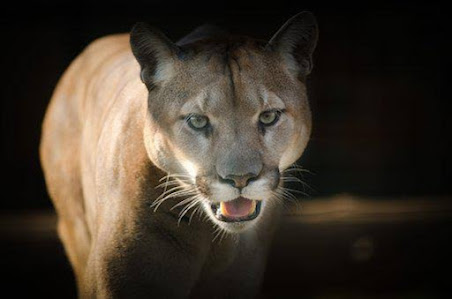 |
| Puma face look like a female African lion, hence the name mountain lion. Image credit: IanZA / Pixabay |
When sitting down, a cougar may leap upward to 18 feet. They have the capacity to horizontally leap a distance range of up to 40 feet. They are one of the biggest cats in the world today. And unlike other large cats, they cannot roar, instead, they purr like a domestic cat.
Domestic cats and cougars both have comparable body types, only that cougars are much larger. You rarely see them in the wild, as they are good at concealing themselves. From the time they are born to 10 months, they have spots that help them to conceal their environment.
The eyes of Cougar kittens are closed at birth, just like those of the domestic cat. Their newborn blue eyes open wide when they are about 2 weeks old and later turn greenish yellow around sixteen months.
5. Leopard
 |
| Image credit: Sumeet Moghe |
Scientific Name: Panthera pardus
Avg. Weight: 28 to 90 kg (62 to 200 Ibs)
Avg. Shoulder Height: 57 to 70 cm (22.4 to 25.2 inches)
Avg. Length: 3.0 to 6.3 ft (91 to 191 cm)
Avg. Tail Length: 1.9-3.6 ft (58 to 110 cm)
Coat color: From pale yellow to gray to chestnut with dark spots in a rosette pattern
Lifespan:10 to 15 Years in the wild & Up to 23 Years in captivity
Habitat: Shrub lands, forests, mountain habitats, and woodlands
Range: Sub-Saharan Africa, northeast Africa, Central Asia, India, and China.
IUCN Red List Status: Vulnerable
Unlike other large cats, the leopard has the ability to adapt to various geographic locations, for this, they have the widest range of habitat. They are certainly one of the biggest cats in the world in 2025 and they are incredibly strong among the big cats.
They have strong limbs which help them to climb and even to carry heavy prey to the tree tops. They do take their prey up to the tree to guide it from hyenas and lions. They have renowned agility, they can leap up to 6m horizontally and 3m vertically.
They run at a speed of 58km/h. They are great swimmers as well. They are territorial solitary animals. Just like domesticated cats, when they are content, they will purr and when angry they will growl.
As mentioned earlier, both black jaguars and leopards are called black panthers. Even though they are rare and many considered them mysterious cats. These black leopards have dark fur that makes the distinctive dark spots called rosettes to be difficult to see.
This feature called melanism is caused as a result of an increase in the amount of black or nearly black pigmentation. Being black helps them conceal themselves at night. But the challenge for black panthers has been an ineffective way of communicating with other spotted cats.
See also:
6. Cheetah
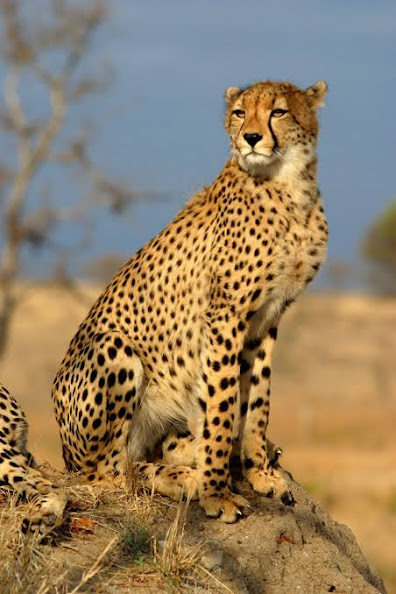 |
| Image credit: James Temple |
Scientific Name: Acinonyx jubatus
Avg. Weight: 35 to 65 kg (77 to 143 lbs)
Avg. Height: 70 to 90 cm (28 to 35 inches)
Avg. Length: 112 to 150 cm (44 to 59 inches)
Avg. Tail Length: 66 to 84 cm (26 to 33 inches)
Coat color: grayish white, pale buff, and tawny with the under part being whiter or paler
Lifespan: 8 to 10 Years in the wild & 12 to 15 Years in captivity
Habitat: temperate to hot deserts, savannahs, grasslands, & shrublands
Range: Sub-Saharan Africa, Middle East, and central India
IUCN Red List Status: Vulnerable
Its name Cheetah is from the Hindi word, Chita, meaning "spotted one". They are sometimes mistaken for leopards since they have similar looks. There are different ways you can clearly differentiate them.
The first way is the spot on their body, cheetahs have an oval or round spot in their coat whereas leopards have rosettes. Two, if you look at a cheetah's face, you will see a pair of dark-colored curved lines running between its nose and cheeks, whereas leopards do not have this.
Thirdly, cheetahs are lighter, more slender, and taller than leopards. There are five known subspecies of cheetahs and all these subspecies are vulnerable on the IUCN list, except the Asiatic cheetah and the Northwest African which are even critically endangered.
This big cat has many titles, as they are amazing like other biggest cats in the world. This big cat is the world's fastest land animal. They are blistering fast that in 3 seconds, they can reach a speed of 64 miles per hour.
In less than a minute, they can cover a distance of 200 to 300 meters. They are able to run amazingly so fast because they have huge muscles that expand fast, their large nostrils, long tail, light skeleton, and flexible spine play important roles in their speed.
They accelerate faster than some sports cars. Only they can maintain this high speed for a short period of time depending on the ground and weather. Their social life is unique as the male live together while females live solitary lives. They hiss and purr, but they do not roar.
7. Snow Leopard
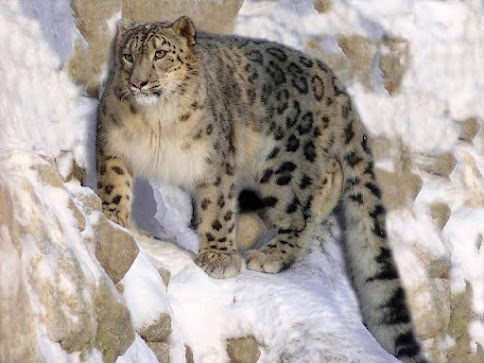 |
| Image credit: Irbis1983 |
Scientific Name: Panthera uncia
Avg. Weight: 34 to 54 kg (75 to 120 lbs)
Avg. Height: 56 to 66 cm (22 to 26 inches)
Avg. Length: 91 to 130 cm (36 to 51 inches)
Avg. Tail Length: 79 to 99 cm (31 to 39 inches)
Coat color: Whitish to grey to yellow with black spots on the head and neck, with larger rosettes on the back
Lifespan: 8 to 15 Years in the wild & 18 to 22 Years in captivity
Habitat: high mountains and Himalayas
Range: Central Asia
IUCN Red List Status: Vulnerable
Even though it is called snow leopard and looks alike with similar patterns on their fur to leopard, they are more related to tigers than the leopard. They are separate animals from leopards, that is they are their own distinct separate wild cat.
They are also called ounces. They have a special ability to change color, they are yellow-gray in the summer and white in the winter. Their fur helps them to adapt well to cold weather. On their belly, their fur has a length close to 12 cm long.
While on their back, their coat can be 5 cm long. This keeps them warm during the winter including their 79 to 99 cm (31 to 39 inches) long tail. Generally, Snow leopard feed on birds, small rodents, Himalayan tahr, ibex, and the like.
While snow leopards in Nepal feed mainly on blue sheep. After feeding on blue sheep, they remain satisfied for a week. This big cat prefers high elevation, usually, about 3,000 to 4,500 meters on ravines, rocky outcrops, and cliffs.
They are capable of leaping up to 9 meters which is six times their body length. Sadly, they are vulnerable due to conditions such as habitat loss, climate change, and poaching for illegal trade.
8. Eurasian Lynx
 |
| Image credit: Aconcagua (talk) |
Scientific Name: Lynx lynx
Avg. Weight: 18 to 36 kg (about 40 to 80 pounds)
Avg. Shoulder Height: 60–71 cm (24–28 inches
Avg. Length: 70 to 130 cm (about 28 to 51 inches)
Avg. Tail Length: 11 to 24.5 cm (4.3 to 9.6 inches)
Coat color: grizzled grayish, yellowish gray or silver-gray in winter, brownish or reddish in summer
Lifespan: 13 to 15 Years in the wild & more than 20 Years in captivity
Habitat: Slopes of the Himalayas, Tibetan Plateau, Arctic tundra, barren rocky areas, thick scrub, semi-deserts, open wooded regions, deciduous and mixed forests.
Range: Europe, Russia, Central Asia, East Asia, and Siberia
IUCN Red List Status: Least Concern
It is the largest of all the lynx specie. They are one of the most distributed ranges of cat species. They are among the top 10 biggest cats in the world in 2025 and the 3rd largest predator in Europe. It has large feet and long legs.
At the tip of their ears, they have black tuft and you will notice their sharp retractile claws at the paws. They feed on small animals such as hares and roe deer. They are very introverted animals.
The incredibly faint, frequently undetectable sounds it generates allow for their presence to go undiscovered for years. They spend the majority of their time at night or during crepuscular hours (active during dawn and dusk). During the day, in lush vegetation, they snooze all day long.
Habitat loss and hunting have been the major threat to their lives. There was a time in the 1930s when they were nearly extinct, but thanks to conversational works, they were able to be referred to the population back in the past 50 years.
9. Clouded Leopard
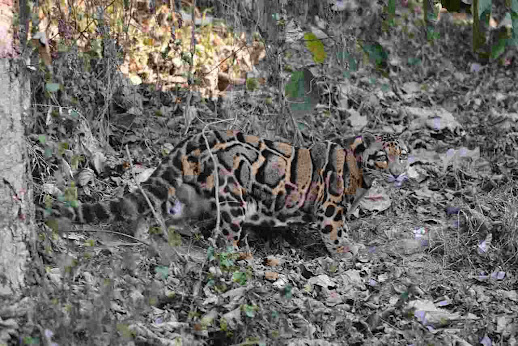 |
| Image credit: Dr. Raju Kasambe |
Scientific Name: Neofelis nebulosa
Avg. Weight: 11 to 23 kg (25 to 50 lbs)
Avg. Height: 46 to 56 cm (18 to 22 inches)
Avg. Length: 61 to 91 cm (27 to 43 inches)
Avg. Tail Length: 61 to 91 cm (24 to 36 inches)
Coat color: Range from pale yellow to grey or brown
Lifespan: 12 to 15 Years in the wild & 17 to 20 Years in captivity
Habitat: Lowland tropical rainforests, dry woodlands, mangrove swamps, and foothills of the Himalayas
Range: Southeast Asia
IUCN Red List Status: Vulnerable
Like snow leopards, clouded leopards are not a type of leopard as the name suggest. They are separate species of wild cats, being undeniably one of the biggest cats in the world. In Borneo, they have a healthy population there due to the lack of leopards and tigers in the area.
They have wide, agile paws with modified footpads for gripping branches, this helps them to adapt well to their environment in forests. They have specially designed anklebones which enable them to involve in a variety of climbing positions, particularly the headfirst slopes of trees.
They have longer canine teeth in ratio to their skull size compares to other big cats. And they can amazingly open their mouth at an angle of 100 degrees. It has a long tail and short legs.
They roar like some large cats but they cannot purr because of the absence of fully ossified hyoid bone. Clouded leopards mainly ambush from the tree or sometimes stalk from the ground and they feed on birds, rodents, wild boars, small deer, slow loris, macaques, and gibbons.
See also:
The Top 15 Cutest Cats In The World (+ Beautiful Fluffy Cats)
10. Caracal
 |
| Image credit: Derek Keats from Johannesburg, South Africa |
Scientific Name: Caracal caracal
Avg. Weight: 7 to 20 kg (15 to 45 lbs)
Avg. Height: 41 to 51 cm (41 to 51 cm)
Avg. Length: 61 to 107 cm (24 to 42 inches)
Avg. Tail Length: 23 to 33 cm (9 to13 inches)
Coat color: Solid colored reddish tan with a lighter underbelly and white eyeliner
Lifespan: 10 to 12 Years in the wild & 15 to 20 Years in captivity
Habitat: scrub forests, savannahs, and woodlands
Range: South Africa, Central Africa, West Africa, southwest Asia, and the Middle East
IUCN Red List Status: Least Concern
They are known for their ability to leap at a distance of 10 feet high. They are also known as gazelle cats and Persian lynxes. Their distinctive characteristic is the tip of their ears which have long tufts of black hair.
And that is the meaning of their name Caracals which means black ears. Their front leg is shorter than their hind legs. They have the ability to leap into the air and catch birds because they have sturdy legs that act like springs because these legs are powerfully built.
This makes them a highly proficient hunters including their agility and their cunning way of hunting. Like other cats, they are carnivorous and feed on small animals such as reptiles, rabbits, rodents, goats, small antelopes, and large insects. At birth, kittens have curled ears and eyes closed until three weeks.
+ Maine Coon Cat - The Biggest Domestic Cat in the World
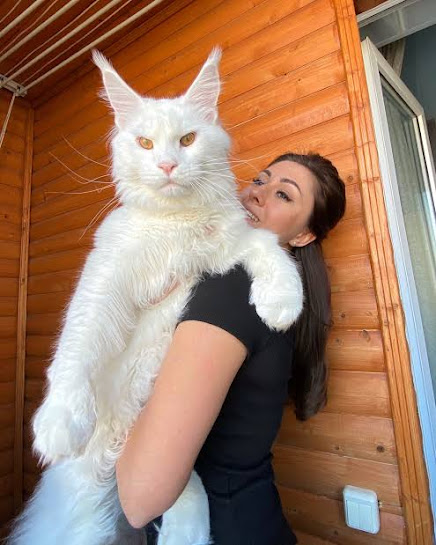 |
| Image credit: My Modern Met |
Scientific Name: Felis catus
Avg. Weight: 4.5 to 11.3 kg (10 to 25 lbs)
Avg. Height: 25 to 40 cm (10 to 16 inches)
Avg. Length: 48 to 81 cm (19 to 32 inches)
Avg. Tail Length: 11 to 16 inches (27.9 to 40.6 cm)
Coat colors: red, black, blue, cream, and White with smoky solid tabby-shaded patterns
Lifespan: 9 to15 years
They are the largest domestic cat breed. They are intelligent gentle giants. As the name implies, it is a cat breed that hails from Maine, United States. Due to the appearance of this cat, there is a misconception that the cat was bred from a raccoon and a cat.
This is because this breed has tufts of fur around its forehead and a broad chest with a fluffy tail. One of the main reason why this cat is so big is that they attain maturity slowly. This brings about the muscles and bone structures to grow larger. The environment may also have an effect on them for being huge. Above all, they are bred to be massive.
Because of their usual huge size, they often break records. For example, presently the Barivel cat is the biggest Maine coon cat holding the world record as the longest-living cat with which its total length is 47.2 inches. Other world's biggest house cat breeds include Savannah cats, Norwegian Forest cats, and Ragdoll cats.
What do you think about the biggest cats in the world in 2025 on this list? We will like to know your thought in the comment section below (Post a comment). Please share this article and you can also subscribe to our mailing list for new updates or you can follow us at our social media handles. Thanks for reading!


Wow. I enjoyed reading this article
ReplyDeleteI happy you find it interesting. Thanks!
DeleteThis is interesting, love reading and watching about animals. Its good to have information about them. Thank you for sharing!
ReplyDeleteI am glad that you find it interesting & that you love it.
DeletePost a Comment